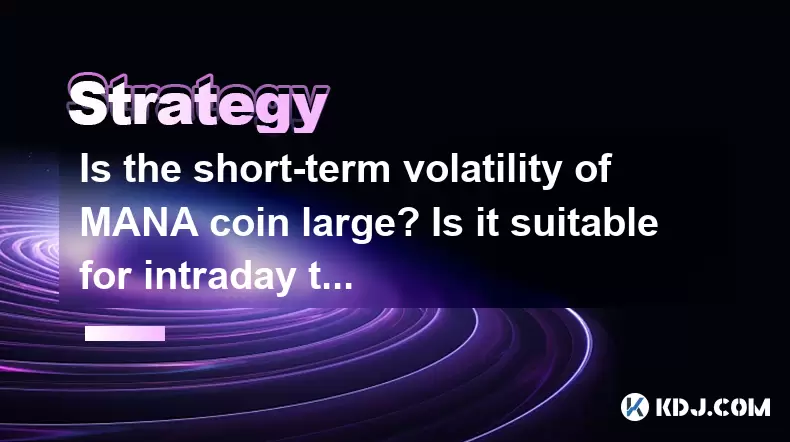-
 bitcoin
bitcoin $122025.899241 USD
-2.12% -
 ethereum
ethereum $4488.068729 USD
-4.11% -
 bnb
bnb $1315.348019 USD
8.65% -
 tether
tether $1.000457 USD
0.03% -
 xrp
xrp $2.875326 USD
-3.69% -
 solana
solana $222.043604 USD
-4.07% -
 usd-coin
usd-coin $0.999682 USD
0.00% -
 dogecoin
dogecoin $0.249887 USD
-5.62% -
 tron
tron $0.337379 USD
-2.59% -
 cardano
cardano $0.827763 USD
-5.06% -
 hyperliquid
hyperliquid $45.774531 USD
-2.43% -
 chainlink
chainlink $22.079309 USD
-5.87% -
 ethena-usde
ethena-usde $1.000156 USD
0.02% -
 sui
sui $3.482566 USD
-3.57% -
 stellar
stellar $0.386982 USD
-4.92%
Is the short-term volatility of MANA coin large? Is it suitable for intraday trading?
MANA coin's high short-term volatility makes it suitable for intraday trading, but traders must use technical analysis and risk management to navigate its rapid price swings.
May 21, 2025 at 03:35 am

The MANA coin, native to the Decentraland platform, has garnered significant attention within the cryptocurrency community due to its association with virtual reality and digital land ownership. A key aspect that traders often consider when evaluating a cryptocurrency for investment or trading is its volatility, particularly in the short term. This article delves into the short-term volatility of MANA coin and assesses its suitability for intraday trading.
Understanding MANA Coin and Its Market Dynamics
MANA, the cryptocurrency of the Decentraland platform, is used to purchase virtual land and other digital assets within the metaverse. The coin's price is influenced by various factors, including the overall sentiment towards metaverse projects, developments within the Decentraland ecosystem, and broader market trends in the cryptocurrency space. Given its niche focus, MANA often experiences significant price fluctuations, which can be attributed to both its specific use case and the general volatility inherent in the crypto market.
Analyzing Short-Term Volatility of MANA Coin
Short-term volatility refers to the rapid price changes that a cryptocurrency undergoes within a short period, typically within a day or a few hours. MANA coin's short-term volatility can be substantial, driven by news related to Decentraland, updates on virtual land sales, and broader market movements. To quantify this, traders often use metrics such as the Average True Range (ATR) or Bollinger Bands to measure the degree of price movement over a given timeframe.
- Average True Range (ATR): This indicator measures market volatility by decomposing the entire range of an asset price for that period. A higher ATR value for MANA would indicate greater short-term volatility.
- Bollinger Bands: These bands consist of a moving average and two standard deviation lines plotted above and below it. When the bands widen, it suggests higher volatility, which is often observed with MANA coin.
Suitability of MANA Coin for Intraday Trading
Intraday trading involves buying and selling assets within the same trading day, capitalizing on short-term price movements. Given MANA's significant short-term volatility, it can be considered suitable for intraday trading, but with certain caveats. Traders need to be well-versed in technical analysis and have a solid risk management strategy in place due to the rapid price swings.
- Technical Analysis: Traders should use tools like candlestick patterns, moving averages, and momentum indicators to identify potential entry and exit points for MANA trades.
- Risk Management: Setting stop-loss orders and having a clear profit target are crucial to mitigate the risks associated with MANA's volatility.
Challenges and Considerations for Intraday Trading MANA
While the volatility of MANA can present lucrative opportunities for intraday trading, it also comes with its set of challenges. Liquidity can be a concern, as the market depth for MANA might not be as robust as for more established cryptocurrencies like Bitcoin or Ethereum. This can lead to slippage, where the executed price differs from the intended price.
Additionally, market sentiment plays a significant role in the price movements of niche cryptocurrencies like MANA. Sudden shifts in sentiment, driven by news or social media trends, can lead to rapid price changes that are difficult to predict and manage.
Tools and Strategies for Trading MANA Intraday
To effectively trade MANA intraday, traders can employ various tools and strategies tailored to its volatility:
- Scalping: This strategy involves making numerous trades throughout the day to profit from small price changes. Given MANA's volatility, scalping can be effective but requires constant monitoring of the market.
- Breakout Trading: Traders can look for breakout points where MANA's price moves beyond a defined resistance or support level, often signaling a continuation of the trend.
- Trading Platforms: Utilizing platforms with real-time data and advanced charting capabilities can help traders make informed decisions. Examples include Binance, Coinbase Pro, and Kraken.
Practical Steps for Intraday Trading MANA
For those interested in trading MANA intraday, here are some practical steps to follow:
- Choose a Reliable Exchange: Select an exchange that offers MANA trading pairs and has a good reputation for security and liquidity. Popular choices include Binance and Coinbase Pro.
- Set Up a Trading Account: Register on the chosen exchange, complete the necessary KYC (Know Your Customer) verification, and deposit funds into your account.
- Configure Trading Tools: Use the exchange's trading interface to set up charts and indicators. Add tools like ATR, Bollinger Bands, and moving averages to your chart for MANA.
- Develop a Trading Plan: Define your entry and exit points, set stop-loss and take-profit levels, and determine the amount you are willing to risk on each trade.
- Monitor the Market: Keep an eye on MANA's price movements and news related to Decentraland. Be prepared to act quickly on potential trading opportunities.
- Execute Trades: Based on your analysis and trading plan, execute buy and sell orders for MANA. Ensure you are using limit orders to manage slippage.
- Review and Adjust: After each trading session, review your trades to assess their performance and adjust your strategy as needed.
Frequently Asked Questions
Q1: How does the volatility of MANA compare to other cryptocurrencies?MANA's volatility is generally higher than that of more established cryptocurrencies like Bitcoin and Ethereum due to its niche focus on the metaverse. However, it can be less volatile than some smaller altcoins with even more specialized use cases.
Q2: What are the typical trading hours for MANA?MANA, like most cryptocurrencies, can be traded 24/7 on various exchanges. However, the most active trading periods often align with major market hours, such as the opening of Asian, European, and American markets.
Q3: Can beginners trade MANA intraday?While it is possible for beginners to trade MANA intraday, it is recommended that they first gain experience with less volatile assets and thoroughly understand the risks involved. Utilizing demo accounts and educational resources can help beginners build confidence and skills before trading MANA.
Q4: What impact do Decentraland updates have on MANA's price?Updates and developments within the Decentraland ecosystem, such as new features, partnerships, or land sales, can significantly impact MANA's price. Positive news often leads to price surges, while negative developments can result in sharp declines.
Disclaimer:info@kdj.com
The information provided is not trading advice. kdj.com does not assume any responsibility for any investments made based on the information provided in this article. Cryptocurrencies are highly volatile and it is highly recommended that you invest with caution after thorough research!
If you believe that the content used on this website infringes your copyright, please contact us immediately (info@kdj.com) and we will delete it promptly.
- BlockDAG, DOGE, HYPE Sponsorship: Crypto Trends Shaping 2025
- 2025-10-01 00:25:13
- Deutsche Börse and Circle: A StableCoin Adoption Powerhouse in Europe
- 2025-10-01 00:25:13
- BlockDAG's Presale Buzz: Is It the Crypto to Watch in October 2025?
- 2025-10-01 00:30:13
- Bitcoin, Crypto, and IQ: When Genius Meets Digital Gold?
- 2025-10-01 00:30:13
- Stablecoins, American Innovation, and Wallet Tokens: The Next Frontier
- 2025-10-01 00:35:12
- NBU, Coins, and Crypto in Ukraine: A New Yorker's Take
- 2025-10-01 00:45:14
Related knowledge

Practical parameter settings for a Bitcoin multi-timeframe moving average system
Sep 18,2025 at 10:54pm
Optimizing Timeframe Combinations for Bitcoin Trading1. Selecting appropriate timeframes is crucial when building a multi-timeframe moving average sys...

How can I filter out false breakouts in Dogecoin high-frequency trading?
Sep 22,2025 at 01:00am
Understanding False Breakouts in Dogecoin Trading1. A false breakout occurs when Dogecoin's price appears to move beyond a defined support or resistan...

Techniques for identifying tops and bottoms in the Bitcoin on-chain NVT model
Sep 20,2025 at 07:54pm
Understanding the NVT Model in Bitcoin Analysis1. The Network Value to Transactions (NVT) ratio is often described as the 'P/E ratio' of the cryptocur...

What does the surge in open interest in Bitcoincoin futures mean?
Sep 20,2025 at 11:18pm
Understanding the Surge in Dogecoin Futures Open Interest1. A surge in open interest within Dogecoin futures indicates a growing number of active cont...

How can I use the Ethereum USDT premium to gauge market sentiment?
Sep 18,2025 at 11:55pm
Understanding the Ethereum USDT Premium1. The Ethereum USDT premium refers to the price difference between USDT (Tether) traded on Ethereum-based plat...

What should I do if Ethereum staking yields decline?
Sep 20,2025 at 06:18am
Understanding the Causes Behind Declining Ethereum Staking Yields1. The Ethereum network transitioned to a proof-of-stake consensus mechanism with the...

Practical parameter settings for a Bitcoin multi-timeframe moving average system
Sep 18,2025 at 10:54pm
Optimizing Timeframe Combinations for Bitcoin Trading1. Selecting appropriate timeframes is crucial when building a multi-timeframe moving average sys...

How can I filter out false breakouts in Dogecoin high-frequency trading?
Sep 22,2025 at 01:00am
Understanding False Breakouts in Dogecoin Trading1. A false breakout occurs when Dogecoin's price appears to move beyond a defined support or resistan...

Techniques for identifying tops and bottoms in the Bitcoin on-chain NVT model
Sep 20,2025 at 07:54pm
Understanding the NVT Model in Bitcoin Analysis1. The Network Value to Transactions (NVT) ratio is often described as the 'P/E ratio' of the cryptocur...

What does the surge in open interest in Bitcoincoin futures mean?
Sep 20,2025 at 11:18pm
Understanding the Surge in Dogecoin Futures Open Interest1. A surge in open interest within Dogecoin futures indicates a growing number of active cont...

How can I use the Ethereum USDT premium to gauge market sentiment?
Sep 18,2025 at 11:55pm
Understanding the Ethereum USDT Premium1. The Ethereum USDT premium refers to the price difference between USDT (Tether) traded on Ethereum-based plat...

What should I do if Ethereum staking yields decline?
Sep 20,2025 at 06:18am
Understanding the Causes Behind Declining Ethereum Staking Yields1. The Ethereum network transitioned to a proof-of-stake consensus mechanism with the...
See all articles










































































